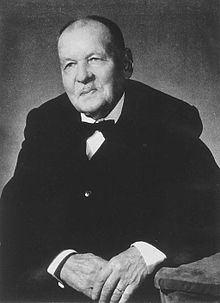André Piganiol
André Piganiol (born January 17, 1883 in Le Havre , † May 23, 1968 in Paris ) was a French ancient historian , epigraphist and archaeologist. He was one of the most prominent representatives of classical studies , especially ancient history, in France in the 20th century.
Live and act
André Piganiol came from a wealthy background. In 1903 he was accepted into the École normal supérieure in Paris, where, among others, René Cagnat was one of his teachers and introduced him to Latin epigraphy and interested him in the subject of Roman tax policy. He had access to the group of students of the sociologist Émile Durkheim and made lifelong friendships with Henri Hubert , Marcel Mauss and Henri Lévy-Bruhl . In 1906 he passed his entrance exam for teaching in the subjects of history and geography. He then went to the École française de Rome as a member that same year. The then director of the institution, the church historian Louis Duchesne , influenced him strongly. In his time in Rome, which lasted until 1909, Piganiol dealt primarily with urban and provincial Roman archeology . After his return to France he was a high school teacher in Alençon , Saint-Quentin and Chambéry until 1919 . From 1914 Piganiol taught in addition to the school service also at the University of Lille . In 1916 he received his doctorate with a thesis on Roman tax policy. In 1919 Piganiol was appointed professor of Roman history at the University of Strasbourg . There he was in contact with Marc Bloch and Lucien Febvre , the founders of the Annales School . The next step in his career took place in 1928 when he was appointed to the Sorbonne in Paris. The high point of his career was his appointment to the ancient history chair of the Collège de France in 1942 . In 1954 Piganiol retired.
Piganiol is considered to be one of the last universal scholars in the field of Roman history. Here he researched all epochs, but placed an emphasis on the early Roman Republic and the late ancient Roman Empire . Unlike many of his specialist colleagues, he was able to come out with both detailed special studies and overview presentations. In addition to history, he also devoted himself intensively to epigraphy and archeology, which he included in his studies. In archeology, he carried out research on the Gallic and Western Roman regions in particular; his studies on the cadastres of Orange are of particular importance . He researched the Roman economy , social history and religious-historical topics. Many of his works reveal a structural-historical approach and thus show Piganiol's closeness to both the Durkheim district and the Annales school. Research on Roman history is now largely considered to be out of date, as it was also influenced by the spirit of the time. His work on the late antique Christian Roman Empire continues to be of lasting value. The work also benefits from the fact that it has now been revised for a second edition by Piganiol's student André Chastagnol . In addition, some individual studies have remained relevant to this day.
The very extensive work of Piganiol was well received and appreciated both in France and abroad. For his achievements he was accepted into the Académie des Inscriptions et Belles-Lettres in 1945 and appointed officer of the Legion of Honor in 1950. In 1951 he was accepted as a corresponding member of the Academy of Sciences and Literature Mainz , and one year later in the Bavarian Academy of Sciences . In 1967 he became a corresponding member of the British Academy . 1953 awarded him the University of Ghent , the honorary doctorate . In Clermont-Ferrand , the Center de recherches André Piganiol was named in his honor.
literature
- Andreas Gutsfeld : Piganiol, André. In: Peter Kuhlmann , Helmuth Schneider (Hrsg.): History of the ancient sciences. Biographical Lexicon (= The New Pauly . Supplements. Volume 6). Metzler, Stuttgart / Weimar 2012, ISBN 978-3-476-02033-8 , Sp. 976-978.
| personal data | |
|---|---|
| SURNAME | Piganiol, André |
| BRIEF DESCRIPTION | French ancient historian, epigraphist and archaeologist |
| DATE OF BIRTH | January 17, 1883 |
| PLACE OF BIRTH | Le Havre |
| DATE OF DEATH | May 23, 1968 |
| Place of death | Paris |
